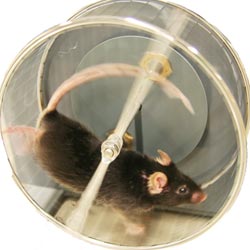Serotonin Mediates Exercise-Induced Generation of New Neurons

Wheel-running Mouse<br>(Photo: Friederike Klempin and Daniel Beis/ Copyright: MDC) <br>
These are the findings of a study by Dr. Friederike Klempin, Daniel Beis and Dr. Natalia Alenina from the research group led by Professor Michael Bader at the Max Delbrück Center (MDC) Berlin-Buch. Surprisingly, mice lacking brain serotonin due to a genetic mutation exhibited normal baseline neurogenesis. However, in these serotonin-deficient mice, activity-induced proliferation was impaired, and wheel running did not induce increased generation of new neurons. (Journal of Neuroscience, Doi:10.1523/JNEUROSCI.5855-12.2013)*.
Scientists have known for some time that exercise induces neurogenesis in a specific brain region, the hippocampus. However, until this study, the underlying mechanism was not fully understood. The hippocampus plays an important role in learning and in memory and is one of the brain regions where new neurons are generated throughout life.
Serotonin facilitates precursor cell maturation
The researchers demonstrated that mice with the ability to produce serotonin are likely to release more of this hormone during exercise, which in turn increases cell proliferation of precursor cells in the hippocampus. Furthermore, serotonin seems to facilitate the transition of stem to progenitor cells that become neurons in the adult mouse brain.
For Dr. Klempin and Dr. Alenina it was surprising that normal baseline neurogenesis occurs in mice that, due to a genetic mutation, cannot produce serotonin in the brain. However, they noted that some of the stem cells in serotonin-deficient mice either die or fail to become neurons.
Yet, these animals seem to have a mechanism that allows compensation for the deficit, in that progenitor cells, an intermediate stage in the development from a stem cell to a neuron, divide more frequently. According to the researchers, this is to maintain the pool of these cells.
However, the group of wheel-running mice that do not produce serotonin did not exhibit an exercise-induced increase in neurogenesis. The compensatory mechanism failed following running. The researchers concluded: “Serotonin is not necessarily required for baseline generation of new neurons in the adult brain, but is essential for exercise-induced hippocampal neurogenesis.”
Hope for new approaches to treat depression and memory loss in the elderly
Deficiency in serotonin, popularly known as the “molecule of happiness”, has been considered in the context of theories linking major depression to declining neurogenesis in the adult brain. “Our findings could potentially help to develop new approaches to prevent and treat depression as well as age-related decline in learning and memory,” said Dr. Klempin and Dr. Alenina.
*Serotonin is required for exercise-induced adult hippocampal neurogenesis
Friederike Klempin1,*,#, Daniel Beis1,#, Valentina Mosienko1, Gerd Kempermann2,3, Michael Bader1, and Natalia Alenina1,*
1Max-Delbruck-Center for Molecular Medicine (MDC), 13125 Berlin, Germany
2Center for Regenerative Therapies Dresden (CRTD), 01307 Dresden, Germany
3German Center for Neurodegenerative Diseases (DZNE) Dresden, 01307 Dresden, Germany
* Corresponding authors # contributed equally
Contact:
Barbara Bachtler
Press Department
Max Delbrück Center for Molecular Medicine (MDC) Berlin-Buch
in the Helmholtz Association
Robert-Rössle-Straße 10
13125 Berlin, Germany
Phone: +49 (0) 30 94 06 – 38 96
Fax: +49 (0) 30 94 06 – 38 33
e-mail: presse@mdc-berlin.de
Media Contact
All latest news from the category: Life Sciences and Chemistry
Articles and reports from the Life Sciences and chemistry area deal with applied and basic research into modern biology, chemistry and human medicine.
Valuable information can be found on a range of life sciences fields including bacteriology, biochemistry, bionics, bioinformatics, biophysics, biotechnology, genetics, geobotany, human biology, marine biology, microbiology, molecular biology, cellular biology, zoology, bioinorganic chemistry, microchemistry and environmental chemistry.
Newest articles

Sea slugs inspire highly stretchable biomedical sensor
USC Viterbi School of Engineering researcher Hangbo Zhao presents findings on highly stretchable and customizable microneedles for application in fields including neuroscience, tissue engineering, and wearable bioelectronics. The revolution in…

Twisting and binding matter waves with photons in a cavity
Precisely measuring the energy states of individual atoms has been a historical challenge for physicists due to atomic recoil. When an atom interacts with a photon, the atom “recoils” in…

Nanotubes, nanoparticles, and antibodies detect tiny amounts of fentanyl
New sensor is six orders of magnitude more sensitive than the next best thing. A research team at Pitt led by Alexander Star, a chemistry professor in the Kenneth P. Dietrich…





















